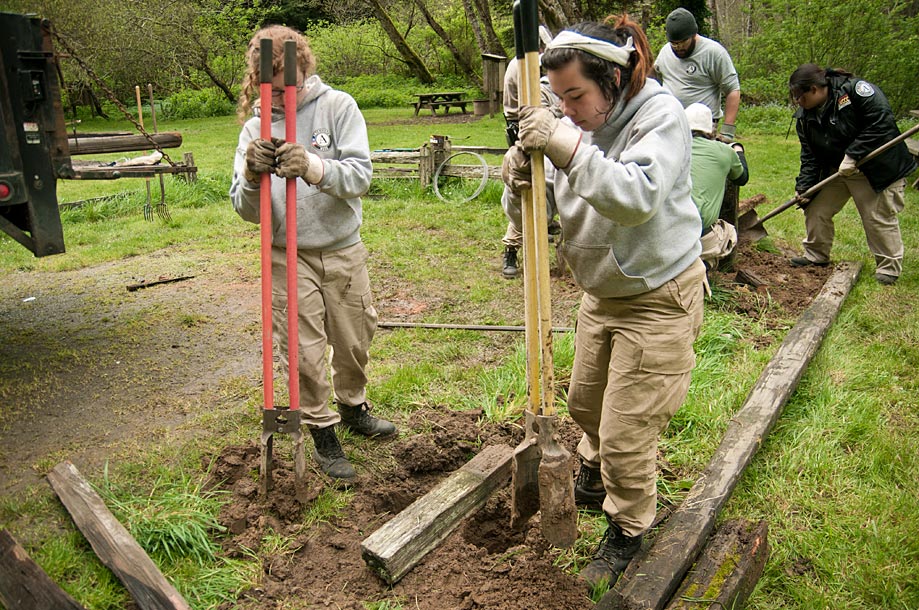Working with California State Parks
/Sarah Gadomski stencils "DPR" (Department of Parks and Recreation) on tables in a building in Russian Gulch State Park near Mendocino, CA. California State Parks recently acquired multiple tables and chairs and assigned us to "brand" them using black paint.
Unopened boxes of tables and chairs purchased by Cal State Parks.
Alyssa Pun stencils "DPR" on a number of chairs.
In another assignment from Cal State Parks, NCCC Corps Members repaired old fencing in Van Damme State Park, just south of Mendocino, CA. The fencing was installed around campsites in the state parks and by the park's entrance in the 1940s and 1950s. The wood used was from old growth redwoods that were cut down earlier in the century. The fences had deteriorated over time and to repair them, we used other old growth redwoods posts that had been sitting around since the mid 1900s. The wood is naturally resilient to weathering, making it a choice wood for fencing.
NCCC Corps Members continue to repair redwood fencing in Van Damme State Park.









 Traditionally, towards the end of the hitch when we are done using our tools for the week, we perform tool maintenance. During an eight-day hitch like this one, multiple tool maintenance sessions are usually a good idea. Tool maintenance is also good for us mentally, as it makes the work day that much shorter. Depending on the tool, maintenance can include sharpening, metal treatment (with motor oil) and wood treatment (sanding and then linseed oil). Here, an NCC crewmember sharpens the edge of a polaski with a file.
Traditionally, towards the end of the hitch when we are done using our tools for the week, we perform tool maintenance. During an eight-day hitch like this one, multiple tool maintenance sessions are usually a good idea. Tool maintenance is also good for us mentally, as it makes the work day that much shorter. Depending on the tool, maintenance can include sharpening, metal treatment (with motor oil) and wood treatment (sanding and then linseed oil). Here, an NCC crewmember sharpens the edge of a polaski with a file. Motor oil is rubbed on this mcleod to help protect it from rusting.
Motor oil is rubbed on this mcleod to help protect it from rusting. Luke puts a cover on this 8-foot perforated lance tooth crosscut saw.
Luke puts a cover on this 8-foot perforated lance tooth crosscut saw.
 The crew commissions single track trail in a recreational area by Pyramid Lake, NV managed by the BLM. We were charged with creating a re-route for OHVs around an area that was recently designated as culturally sensitive. We were apparently not qualified to know what was culturally sensitive about the area, but we gathered that this area, named Spirit Canyon, was of significance to neighboring Native American tribes who perhaps performed rituals in this Canyon. Above, the crew walks through Spirit Canyon.
The crew commissions single track trail in a recreational area by Pyramid Lake, NV managed by the BLM. We were charged with creating a re-route for OHVs around an area that was recently designated as culturally sensitive. We were apparently not qualified to know what was culturally sensitive about the area, but we gathered that this area, named Spirit Canyon, was of significance to neighboring Native American tribes who perhaps performed rituals in this Canyon. Above, the crew walks through Spirit Canyon. After work on Thursday, the last day of hitch, we take a dip into Pyramid Lake.
After work on Thursday, the last day of hitch, we take a dip into Pyramid Lake. The crew walks over the trail at the end of the day to return to camp for the evening.
The crew walks over the trail at the end of the day to return to camp for the evening. A GBI vehicle has no choice but to venture through a flooded road. There were certainly no intact, water-free adjacent roads we could have taken instead.
A GBI vehicle has no choice but to venture through a flooded road. There were certainly no intact, water-free adjacent roads we could have taken instead.
 A week after the NCC summer orientation and formation of new crews built from both old and new members, newly-fashioned NCC crews began work around Nevada. We are building new tread at Wilson Canyon, a gorge of volcanic cliffs cut by the Walker River a little west of Yerington. The new trail will have been started and completed by this crew in a period of two weeks.
A week after the NCC summer orientation and formation of new crews built from both old and new members, newly-fashioned NCC crews began work around Nevada. We are building new tread at Wilson Canyon, a gorge of volcanic cliffs cut by the Walker River a little west of Yerington. The new trail will have been started and completed by this crew in a period of two weeks. On the third day of hitch, winds between 60 and 90 mph picked up, causing a small sandstorm and preventing us from continuing work for the rest of the day.
On the third day of hitch, winds between 60 and 90 mph picked up, causing a small sandstorm and preventing us from continuing work for the rest of the day. Waiting for the entire crew to gather before leaving Wilson Canyon due to severe strong winds.
Waiting for the entire crew to gather before leaving Wilson Canyon due to severe strong winds. Young Kim prepares dinner for the crew after work.
Young Kim prepares dinner for the crew after work. The crew continues building tread.
The crew continues building tread.




































